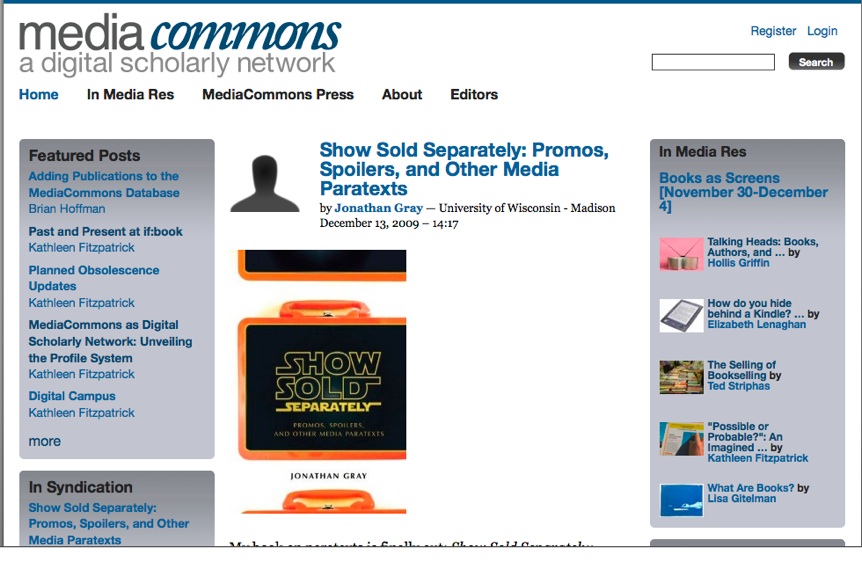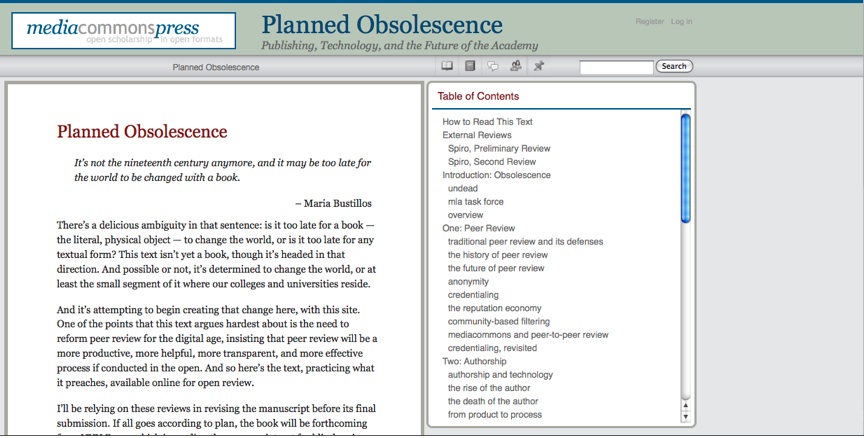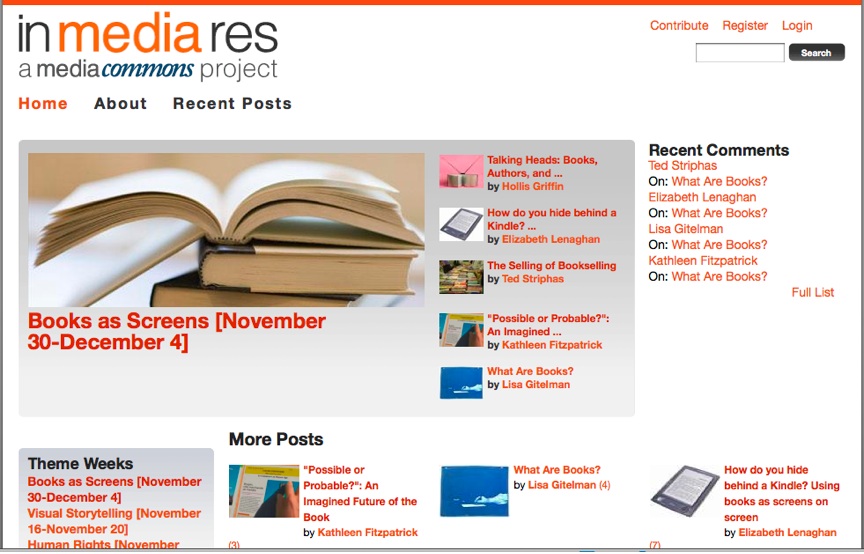(created 1/17/2010; version 1.0)
[Status: Draft]
Related Categories: Social Networking Systems | Tools for Analyzing Social Networks | Online Journals | Online Knowledge Bases
Summary:
MediaCommons is a project led by Kathleen Fitzpatrick and Avi Santo currently in development at USC as part of the Institute for the Future of the Book. The project is a network for media scholars and students, providing access to scholarship beyond traditional peer-reviewed journals in the form of wikis, blogs, journals, and other digital media. A major goal of the project is to re-imagine the scholarly press as a social network through which scholars can, via the affordances of digital network technologies, produce new knowledge about their specific fields. As it stands, MediaCommons also has two projects in development, In Media Res and MediaCommonsPress.
Description:
The MediaCommons project emerged to fill the need for a scholarly press better equipped to negotiate the rapidly evolving model of publishing in humanities and, more specifically, media studies. Using the paradigm of a network became important because, in Fitzpatrick’s words, “the more we thought about the purposes behind electronic scholarly publishing, the more we became focused on the need not simply to provide better access to discrete scholarly texts but rather to reinvigorate intellectual discourse, and thus connections, amongst peers” (Fitzpatrick, Introducing MediaCommons). With the premise of furnishing a space for collaboration in the publishing process, MediaCommons seeks to build and improve relationships between scholars via the documents they work on.
Users of MediaCommons currently have the ability to write, publish, review and discuss various scholarship in different media (blogs, vlogs, wikis, etc). As the project is conceived, several nodes will eventually allow access to electronic monographs, casebooks, journals, reference works, and forums. Even more, the process of creating scholarly work will be made transparent by an open access environment through which readers and reviewers can respond to ideas as they develop. The network will be organized by an editorial board, but is mostly a member-driven site. This board will lead a “peer-to-peer review” in which new scholarly texts are ranked by the MediaCommons community.

Screen Grab of MediaCommons Homepage
The MediaCommons homepage features new posts from members in the central column. To the left are links to “Featured Posts,” “In Syndication” posts, as well as “Recent Blog Posts.” As with common blog sites, each post can receive comments. On the right side of the page are links to a side-project of MediaCommons, “In Media Res,” followed by links to recent podcasts called “The Lion’s Share” by Tim Anderson (offering episodes devoted to new scholarship in media studies), and finally by links to recent comments. Once the user is registered, posts can be made directly to the site upon approval.
Much of the project remains speculative. As it’s imagined, the site’s developers hope to include many more features. First, the site could be streamlined by preference according to users, so that they could customize their own interface according to content they specifically wish to track. The inclusion of electronic monographs would allow users to work collaboratively in order to develop ideas about the various aspects of publishing the monograph, such as its design, production, publicizing, and reviewing. An electronic casebook would open up a space in which scholars could continually update a kind of textbook with content like pedagogical materials, or coursework. An electronic journal would allow users to act as editors, who could compile related articles into one theme-based issue. Using wikis, an electronic reference work would let multiple scholars assemble research according to certain topics. And lastly, electronic forums, which would include threaded discussions and various collections of blogs, would allow users to access a network beyond faculty and students, composed of practitioners, policy makers, fans, independent scholars, critics, journalists, activists, and other interested parties.
Part of this latter projection of the potentials of the project has to do with the wish to expand academic scholarship beyond what the developers consider to be an exclusive and limited audience. Making the composing, revising, collaborating and publishing of scholarly work transparent would demystify the processual nature of scholarly production. In addition, the hope of including a wider reading public is coupled with the open-access paradigm, which stands in contrast to the current proprietary model. As Fitzpatrick explains, a more diversified community would produce scholarship that operates in “modes that are collaborative, interactive, multimediated, networked, nonlinear and multi-accented.” Users on MediaCommons would therefore incorporate various digital modes that aren’t individually owned, or institutionally authorized, but communal, such as message boards, chat rooms, listservs etc.
The community the project envisions is therefore flattened rather than hierarchical. As Santo writes, “scholars should seek to be stewards of intellectual communities… [this model of a community] makes a virtue of building knowledge networks out into “alternative” communities (from an academic point of view), which would be a revitalizing addition to the current dissemination of academic knowledge” (Santo, MediaCommons 2: Renewed Publics, Revised Pedagogies). Rather than a logic of knowledge informed by individual performance then, the project recognizes knowledge as an extension of the community’s intellectual interaction. If this is the case, the community could be situated for providing opportunities for historically marginalized communities to address the ways they’ve been represented and even more importantly, mis-represented.
The main site is linked to several projects in development. First, “In Media Res” offers videos having to do with media scholarship as well as commentary by “curators.” The curators are responsible for choosing a video clip or visual image slideshow under three minutes as well as an accompanying short written piece in response. Some sample titles from the clips are “Talking Heads: Books, Authors, and Television News,” and “Battlestar Redactica: Visual Revision of Narrative Error.”
The project’s homepage highlights a recent post with a large image, and several more recent posts with smaller images below. To the right are links to recent comments. To the bottom left is a box entitled “Theme Weeks” that contains links to videos under a specific theme.
When the user clicks on a video post, the page contains the embedded video, with the “Curator’s Note” offering commentary just to the right. Comments from users are posted in a thread below. Underneath the video are tags to similar videos, as well as RSS links and “Related Posts.”

Screen Grab of MediaCommons Press Homepage
The second project of MediaCommons, also currently in development is called MediaCommonsPress. Based on open access network, the press encourages response from its users to digitally published texts. These texts can be the length of conference papers to full manuscript-length. The first text offered as part of the project is by founder Kathleen Fitzpatrick, entitled Planned Obsolescence: Publishing, Technology, and the Future of the Academy.
When the user clicks on the link, they are taken to a page with a different interface, powered by CommentPress. At the top of the page is the title of the manuscript and beneath it a navigation bar with several icons. The first icon is a table of contents link, the second a link to general comments, the third a link to all comments on the book, the fourth a link to comments by commenter, and the final icon a link to a community blog where users can make more general and open-ended remarks. To the right of the icon bar is a search box.
When the user clicks on a specific page, the page appears in the box on the left, split by paragraph. To the left of each paragraph is a speech bubble icon which, when clicked, opens up a box to the right of the page that allows space for commentary. An icon also allows a user to comment on the whole page. Footnotes can be viewed by rolling over them, and the parameters of the boxes can also be adjusted to fit the user’s preferences. Under the table of contents icon, each section of the book is listed, making navigation convenient.
Research Context:
The MediaCommons project is of interest to those working in the fields of scholarly publishing, particularly with respect to digital affordances and their implementation into the composition and publishing process. Beyond the development of and experimentation with an electronic press and the digital tools this kind of press would require in contrast to those of a print press, the project is also of interest to the field of online social networking. The communities the project hopes to bring about and energize emerge out of and are informed by the digital environments the project is developing. These environments broaden the types of knowledge the community produces as well as how that knowledge is disseminated.
Technical Analysis:
MediaCommons is running in Drupal 6, which is PHP/MySQL based.
Evaluation of Opportunities/Limitations for the Transliteracies Topic:
MediaCommons is useful for Transliteracies, and for the RoSE project in particular, in its underlying paradigm. Like RoSE, MediaCommons is based on the idea of using social networks in order to advance research with this central difference: where RoSE is set up for research, MediaCommons is set up for composition and publication. Both projects assume a fundamental relationship between people and documents. Where RoSE makes visible the relations between social networks and the documents those networks produce, revise, inspire, and critique, MediaCommons makes possible a press where a social network of writers and scholars can produce a publishable, peer-reviewed document in real-time.
Beyond this intellectual framework, the limitations of MediaCommons for RoSE become apparent. The development of RoSE focuses on ways data can be harvested and aligned in order to model certain knowledge formations. The tools that this system requires therefore differ from the tools MediaCommons employs, which essentially use compositional tools like blogs and wikis that multiple users can edit. One can imagine a research path that would employ both systems, however. A scholar would take their initial research question, consult RoSE in order to further develop a research map, and after completion of a draft, post it on MediaCommons in order to receive feedback for revisions.
Resources for Further Study:
- “Introducing MediaCommons” by Kathleen Fitzpatrick. http://www.futureofthebook.org/blog/archives/2006/07/introducing_mediacommons_or_ti.html
- “Renewed Publics, Revised Futures” by Avi Santo http://www.futureofthebook.org/blog/archives/2006/07/mediacommons_2_renewed_publics.html
- “Toward the Establishment of an Electronic Press” by Ben Vershbow http://www.futureofthebook.org/blog/archives/2006/03/toward_the_establishment_of_an.html
- MediaCommons http://mediacommons.futureofthebook.org/
- In Media Res http://mediacommons.futureofthebook.org/imr/
- Commentpress http://www.futureofthebook.org/commentpress/
- Institute for the Future of the Book http://www.futureofthebook.org/blog/

